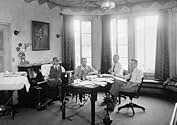Ted Sears(1900-1958)
- Writer
- Animation Department
- Director
As his writing partner, Winston Hibler, once put it, "Perhaps Ted's
greatest talent was his own unique brand of humor. It was warm, gentle
humor; there was never a barb in it. And his was the key, to Ted's
whole personality. He was the kindest man I ever knew. He lived with
laughter and without malice. He was generous in all things. His talents
could be had for the asking. No job was too small, none too big. And
this all adds up to the fact that through his talents and his personal
virtues. Ted was able to achieve two of the goals he set for himself in
life: he made good pictures and he made good friends." Ted Sears was a
man of multiple talents. Born in 1900, he spent most of his childhood
in New York. As a teenager he attended a trade school in Manhattan
where he learned a variety of lettering techniques - since he planned
on becoming a sign painter. Even though art and drawing were his first
loves, his most lasting interests, early on he convinced himself he
would never be an exceptional artist, and he also knew he had to help
support his parents and four sisters. However, trying out various jobs
was not a problem; he was good at almost everything, and so he lettered
title cards for silent movies, worked with trick photography, drew ads
In 1931, Walt Disney hired Ted on a long term contract not as an animator but as a senior writer, (the Disney company's first) and in the twenty-seven years that followed no one ever challenged his position. He had found a niche that suited him, surrounded by the most talented and colorful personalities in animation, writing dialogue and story lines for virtually every important production the Disney Studio made: "Snow White," "Pinocchio," "Bambi," "Dumbo," "Fantasia," "Saludos Amigos," "Cinderella," "Alice in Wonderland," "Peter Pan" (for which he wrote song lyrics), "Lady and the Tramp," and "Sleeping beauty." As part of the Disney's company's original story department he is one of the men attributed in the creation of storyboarding now an industry standard for not just animated film but also live action. He also co-wrote narration for many of the Disney nature films with Winston Hibler, and later did a number of the Disney TV shows. He had writing credits on perhaps a dozen Oscar and Emmy winning productions.
To amuse himself, Ted still drew for his friends and made props for the plays his daughter appeared in - he also produced his family's Christmas cards which employed his old love for trick photography an special effects - these holiday cards took months to prepare and were awaited with great anticipation by over three hundred recipients. (he lettered the envelopes individually, turning each name into calligraphy.)
When Ted died in the summer of 1958, he left his mark on the Disney films, their quality in part springing from his belief in what he did, his many gifts, and the satisfaction that came from working with the finest talents in the animation business.
- and even made props for early two-reel comedies, joining silent comic
In 1931, Walt Disney hired Ted on a long term contract not as an animator but as a senior writer, (the Disney company's first) and in the twenty-seven years that followed no one ever challenged his position. He had found a niche that suited him, surrounded by the most talented and colorful personalities in animation, writing dialogue and story lines for virtually every important production the Disney Studio made: "Snow White," "Pinocchio," "Bambi," "Dumbo," "Fantasia," "Saludos Amigos," "Cinderella," "Alice in Wonderland," "Peter Pan" (for which he wrote song lyrics), "Lady and the Tramp," and "Sleeping beauty." As part of the Disney's company's original story department he is one of the men attributed in the creation of storyboarding now an industry standard for not just animated film but also live action. He also co-wrote narration for many of the Disney nature films with Winston Hibler, and later did a number of the Disney TV shows. He had writing credits on perhaps a dozen Oscar and Emmy winning productions.
To amuse himself, Ted still drew for his friends and made props for the plays his daughter appeared in - he also produced his family's Christmas cards which employed his old love for trick photography an special effects - these holiday cards took months to prepare and were awaited with great anticipation by over three hundred recipients. (he lettered the envelopes individually, turning each name into calligraphy.)
When Ted died in the summer of 1958, he left his mark on the Disney films, their quality in part springing from his belief in what he did, his many gifts, and the satisfaction that came from working with the finest talents in the animation business.



























